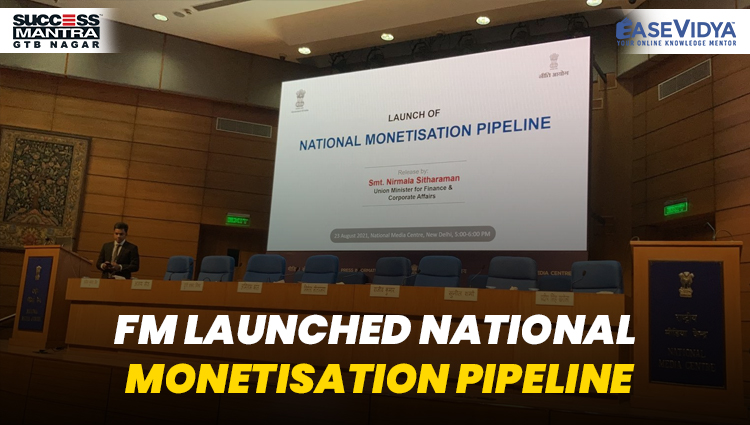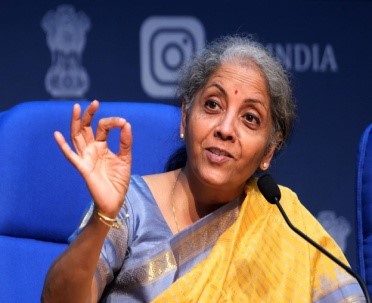
FM LAUNCHED NATIONAL MONETISATION PIPELINE
FM LAUNCHED NATIONAL MONETISATION PIPELINE

Union Finance Minister Nirmala Sitharaman launched the National Monetisation Pipeline in Delhi on August 23, 2021. Finance Minister Nirmala Sitharaman said that National Monetization Pipeline talks about brownfield assets where investment is already being made, where there are assets either languishing or not fully monetized or under-utilized. By bringing in private participation, we are going to monetize it (assets) better and with whatever resource that you obtained by monetization, you are able to put in for further investment into infrastructure building." The NMP estimates aggregate monetisation potential of Rs 6 lakh crores through core assets of the Central Government, over a four-year period, from FY 2022 to FY 2025. The plan is in line with Prime Minister's strategic divestment policy, under which the government will retain presence in only a few identified areas with the rest tapping the private sector.
ABOUT THE NATIONAL MONETISATION PIPELINE

It aims to unlock value in brownfield projects by engaging the private sector, transferring to them revenue rights and not ownership in the projects, and using the funds generated for infrastructure creation across the country. The NMP has been announced to provide a clear framework for monetisation and give potential investors a ready list of assets to generate investment interest. Union Budget 2021-22 has identified monetisation of operating public infrastructure assets as a key means for sustainable infrastructure financing. Currently, only assets of central government line ministries and Central Public Sector Enterprises (CPSEs) in infrastructure sectors have been included. The government has stressed that these are brownfield assets, which have been “de-risked” from execution risks, and therefore should encourage private investment. Roads, railways and power sector assets will comprise over 66% of the total estimated value of the assets to be monetised, with the remaining upcoming sectors including telecom, mining, aviation, ports, natural gas and petroleum product pipelines, warehouses and stadiums.
In terms of annual phasing by value, 15% of assets with an indicative value of Rs 0.88 lakh crore are envisaged for rollout in the current financial year. The NMP will run co-terminus with the Rs 100 lakh crore National Infrastructure Pipeline (NIP) announced in December 2019. The estimated amount to be raised through monetisation is around 14% of the proposed outlay for the Centre of Rs 43 lakh crore under NIP. NIP will enable a forward outlook on infrastructure projects which will create jobs, improve ease of living, and provide equitable access to infrastructure for all, thereby making growth more inclusive. NIP includes economic and social infrastructure projects. Other Initiatives for Infrastructure Development include Scheme of Financial Assistance to States for Capital Expenditure, Industrial corridors, etc.
WHAT IS MONETISATION?
In a monetisation transaction, the government is basically transferring revenue rights to private parties for a specified transaction period in return for upfront money, a revenue share, and commitment of investments in the assets. Real Estate Investment Trusts (Reits) and Infrastructure Investment Trusts (Invits), for instance, are the key structures used to monetise assets in the roads and power sectors. These are also listed on stock exchanges, providing investors liquidity through secondary markets as well. While these are a structured financing vehicle, other monetisation models on PPP (Public Private Partnership) basis include:
- Operate Maintain Transfer (OMT),
- Toll Operate Transfer (TOT), and
- Operations, Maintenance & Development (OMD).
GREENFIELD VS BROWNFIELD INVESTMENT

- Greenfield Project: It refers to investment in a manufacturing, office, or other physical company-related structure or group of structures in an area where no previous facilities exist.
- Brownfield investment: The projects which are modified or upgraded are called brownfield projects. The term is used for purchasing or leasing existing production facilities to launch a new production activity.
ASSOCIATED CHALLENGES
Lack of identifiable revenue streams in various assets. The slow pace of privatisation in government companies including Air India and BPCL. Further, less-than-encouraging bids in the recently launched PPP initiative in trains indicate that attracting private investors' interest is not that easy.
Asset-specific Challenges:
- Low Level of capacity utilisation in gas and petroleum pipeline networks.
- Regulated tariffs in power sector assets.
- Low interest among investors in national highways below four lanes.
- Konkan Railway, for instance, has multiple stakeholders, including state governments, which own stake in the entity.
CONCLUSION
Execution is the Key: While the government has tried to address many challenges, owing to infrastructure development in the NMP framework, execution of the plan remains key to its success.
Dispute Redressal Mechanism: Further, there is a need for an efficient dispute resolution mechanism.
Multi-Stakeholder Approach: The success of the infrastructure expansion plan would depend on other stakeholders playing their due role. These include State governments and their public sector enterprises and the private sector. In this context, the Fifteenth Finance Commission has recommended the setting up of a High-Powered Intergovernmental Group to re-examine the fiscal responsibility legislation of the Centre and States.
TEST YOURSELF
Q.1 Which of the following Union Ministers have recently launched the National Monetization pipeline?
- Nirmala Sitaraman: ANSWER
- Narayan Tatu Rane
- Narendra Singh Tomar
- Piyush Goyal
Q.2 The NMP estimates aggregate monetisation potential of Rs 6 lakh crores through core assets of the Central Government, over a four-year period, from _________?
- FY 2021 to FY 2024
- FY 2022 to FY 2026
- FY 2022 to FY 2025: ANSWER
- None of the following
Q.3 Where does the Government wish to spend the funds generated through this Asset monetization Project?
- Building airports across the country
- Building road network across the country
- Building Housing societies across the country
- All of the above: ANSWER
Q.4 Which of the following is correct regarding the amount that is being estimated to be raised through the National Monetisation Pipeline?
- Five thousand crore
- Six thousand crore
- Six lakh crore: ANSWER
- Seven lakh crore
Q.5 What is one word for the government transferring revenue rights to private parties for a specified transaction period in return for money?
- Demonetization
- Monetization: ANSWER
- Asset dissolution
- None of the above













FiveM Mlo
https://www.fivemmlo.net/ FiveM MLO (Multi-Level Object) is a custom object that can be add to a Fivem server. They are designe to be fully interactive with the game environment, allowing player to interact with objects in ways that would not be. At our FiveM MLO store, we are committe to providing the highest quality and most immersive MLOs for your server. Here’s why you should choose us. Buying Fivem MLOs enhances your gaming experience by providing unique, customize maps, houses, and interiors, adding immersive and exclusive elements to your Fivem server.
FiveM Mlo
https://www.fivemmlo.net/ FiveM MLO (Multi-Level Object) is a custom object that can be add to a Fivem server. They are designe to be fully interactive with the game environment, allowing player to interact with objects in ways that would not be. At our FiveM MLO store, we are committe to providing the highest quality and most immersive MLOs for your server. Here’s why you should choose us. Buying Fivem MLOs enhances your gaming experience by providing unique, customize maps, houses, and interiors, adding immersive and exclusive elements to your Fivem server.